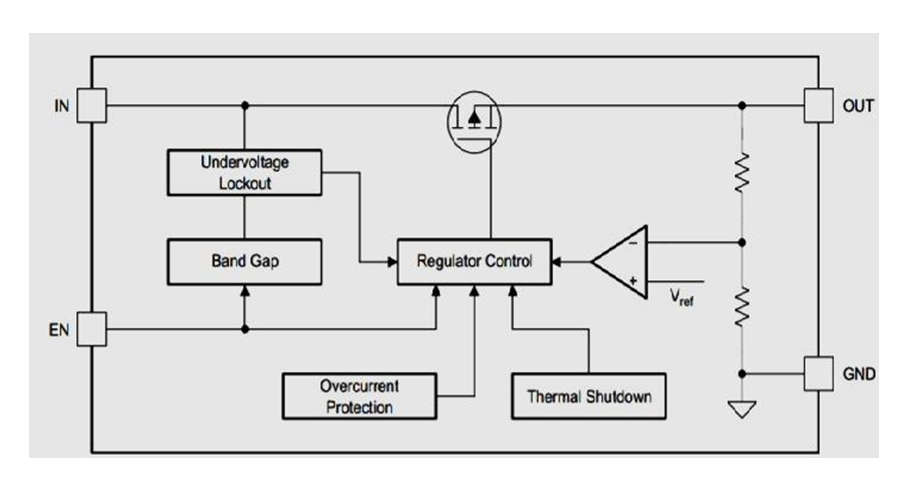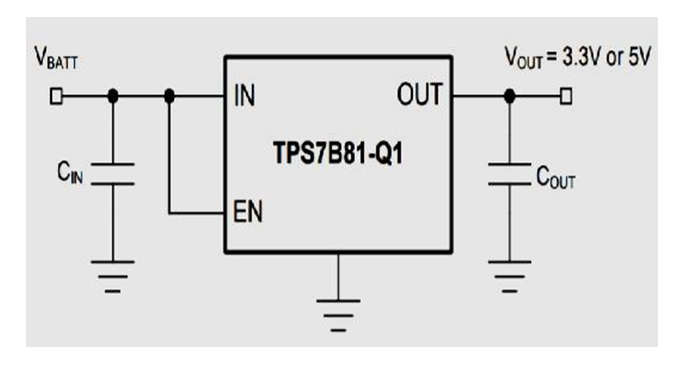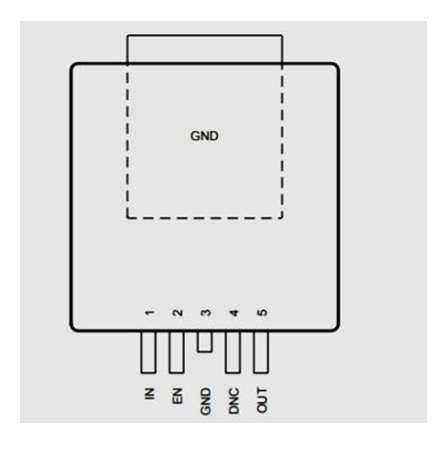- TPS7B81-Q1 is a low dropout voltage, ultralow quiescent current regulator. It can operate with a 40V input voltage. The TPS7B81-Q1 has built-in fault protection circuits. This LDO is available in a variety of sizes and thermal conductivity levels. Because of its low quiescent current, the TPS7B81-Q1 is regarded as an ideal solution for powering microcontrollers, control area networks, and local interconnect networks.
Block Diagram

Under Voltage Shutdown:
- This device has an internal Under voltage lockout circuit that shuts down the output when input voltages fall below an internal UVLO threshold. This circuit prevents the device from locking into an unknown state when the input voltage is low.
Current Limit:
- When an overload or output shorting occurs, a current limit circuit is provided to the device to keep it in a safe operating area. This IC is also protected from excessive power dissipation by a current limit protection circuit.
Thermal Shutdown:
- A thermal shutdown circuit is provided to protect the LDO from overheating. This circuit shuts down the device when the junction temperature exceeds the thermal shutdown trip point. When the device cools to a temperature lower than the thermal shutdown point, this circuit reactivates the output.
Circuit Diagram of TPS7B81-Q1

- External components such as capacitors of varying values are used in conjunction with this LDO, depending on the application requirements. Before beginning the design process, determine the input voltage range, output voltage range, and output current values.
Input Capacitor:
- Typically, a 10-F to the 22-F capacitor is connected from the IN pin to the ground. An input capacitor can improve the device’s transient response, input ripple rejection, and PSRR.
Output Capacitor:
- For stability, this LDO requires an output capacitor. A capacitor in the 1F to 200F range is preferred. The capacitor’s ESR range should be between 0.001 and 5. A ceramic capacitor with a low ESR is chosen to improve the load transient response.
Pin Configuration of TPS7B81-Q1

- TPS7B81-Q1 is offered in 8-pin HVSSOP DGN, 6-pin WSON DRV, and 5-pin TO-252 KVU packages.
DGN Package:
- Pin-1 is the power supply input pin IN. An input capacitor is recommended to reduce input impedance and achieve the best transient response. This capacitor is connected from the IN pin to the ground and should be placed as close to the device’s output as possible.
- EN is the Enable input pin. By driving this pin higher than the device’s logic input high level, the device is turned on. When the value at this pin is less than the logic-input low level, TPS7B81-Q1 enters shutdown mode.
- Pins 3 and 7 are not connected internally. GND ground reference pins are pins 4, 5, and 6. The regulated output pin OUT is pin-8. An output capacitor should be placed between OUT and ground for stability. This capacitor should be placed as close to the device’s output as possible.
DRV Package:
- Pin-1 is the IN (input) pin.
- Pin-2 is the EN enable pin.
- GND is the ground reference pins 3 and 4.
- The DNC pin is located on Pin 5. It must not be linked to any bias voltage. This pin is either grounded or left dangling.
- Pin-6 is the OUT (output) pin. The pin’s operation is similar to that of the DGN package’s pins, but their configuration differs.
KVU Package:
- Pin-1 is the IN (input) pin. EN is the enable input pin on Pin-2.
- GND is the ground reference pin -3 and TAB. The DNC pin is located on Pin 4. Pin-5 is the OUT (output) pin.
- All of the packages’ thermal pads are connected to the ground GND for improved thermal performance.
Specifications
- PS7B81-Q1 is a low dropout, ultra-low IQ, off-battery regulator.
- Temperature grade 1 ranges from -400°C to 1250°C.
- The TPS7B81-Q1 has an input voltage range of 3-V to 40-V.
- This device’s maximum output current is 150mA.
- When in shutdown mode, the TPS7B81-Q1 has a low quiescent current of 300nA.
- The typical quiescent current value for light loads is 2.7A.
- For light loads, a maximum quiescent current of 4.5A is obtained.
- TPS7B81-Q1 has an output-voltage accuracy of 1.5 percent over the line, load, and temperature.
- TPS7B81-Q1 has a maximum dropout voltage of 525mV at 150mA for a fixed 5V output version.
- For stability, a ceramic output capacitor with a value ranging from 1F to 200F and a low ESR is used.
- This IC is available in fixed voltage versions with output voltages of 5V and 3.3V.
- This LDO is equipped with fault protection circuits.
- TPS7B81-Q1 also has a thermal shutdown circuit, a short-circuit protection circuit, and an overcurrent protection circuit.
- TPS7B81-Q1 is available in three package types: 8-pin DGN, 6-pin DRV, and 5-pin KVU.
Applications
- TPS7B81-Q1 is the power supply for the cluster.
- Body control modules also include a TPS7B81-Q1 voltage regulator.
- TPS7B81-Q1 is an excellent choice for battery-powered always-on applications such as gateway applications and remote keyless entry systems.
- TPS7B81-Q1 is a power supply for MCUs and CAN/LIN transceivers.
